#16th century tomb sculpture
Photo


16th century tomb sculpture
#16th century tomb sculpture#memento mori#skeleton#sculpture#tomb#tomb art#skull#art#16th century#xvi century#random
488 notes
·
View notes
Text
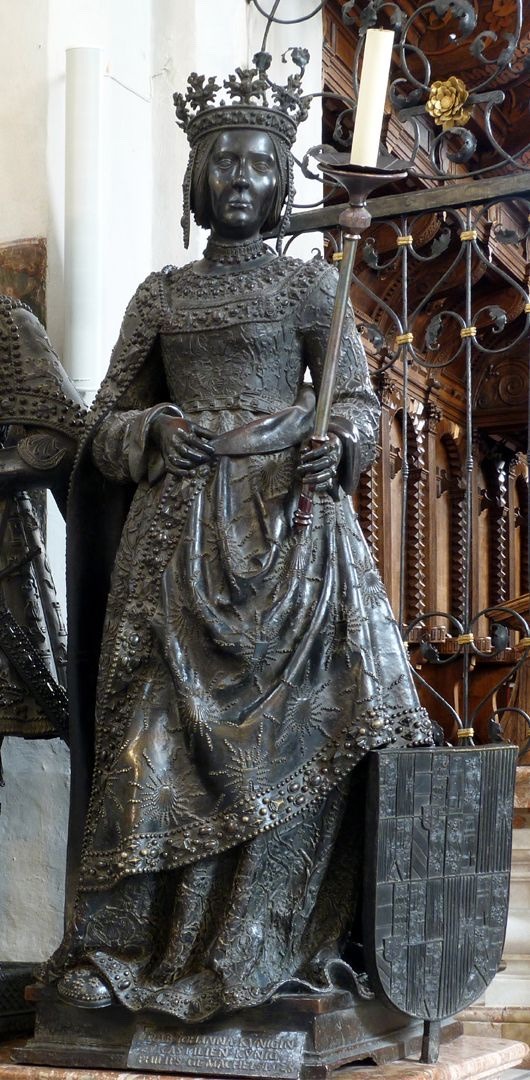

Bronze statues of Juana I of Castile and Archduchess Margaret of Austria in the Empty Tomb of Emperor Maximillian I
#juana of castile#juana i of castile#joanna of castile#Joanna I of Castile#Margaret of Austria#tomb#art#bronze sculpture#bronze statue#northern renaissance art#northern renaissance#renaissance art#renaissance#sixteenth century#16th century art#16th century#art history#history of art#maximilian i#holy roman empire#holy roman emperor
78 notes
·
View notes
Text

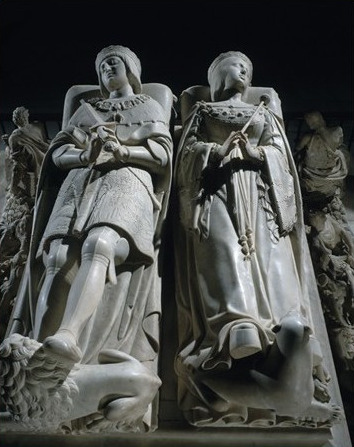


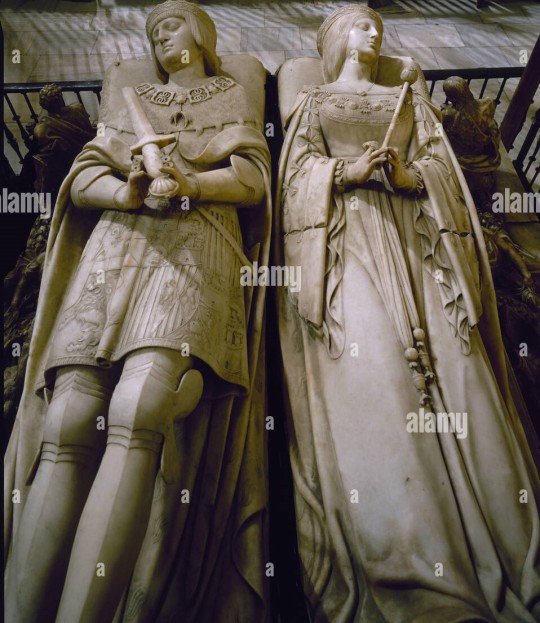


Tombs of Joanna I, Queen of Castile and Philip the Handsome by Bartolome Ordonez, 1519-1520
#bartolome ordonez#spain#Castile#sovereign#tomb#effigy#16th century#mdpsculpture#16th c. sculpture#1510s#1519#16th c. spain#1520#castille
214 notes
·
View notes
Text
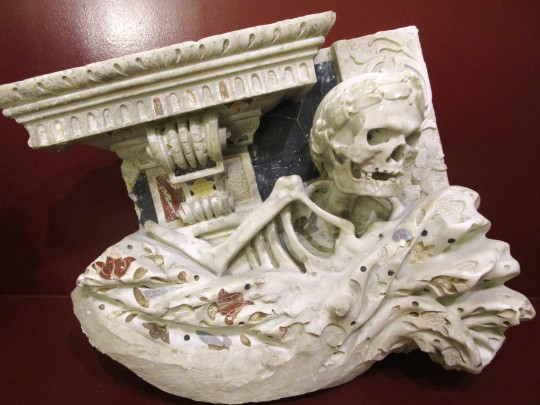
Sculptured fragment from a 16th century tomb
Diocesan Museum of Palermo, Sicily
Photo by Charles Reeza
11 notes
·
View notes
Photo

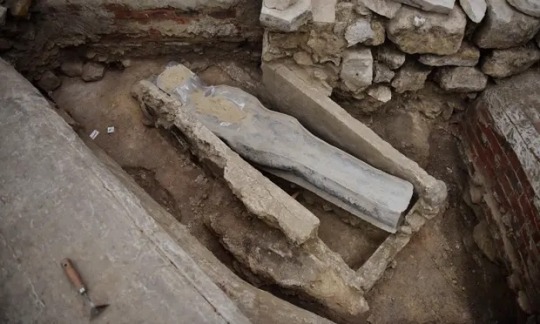
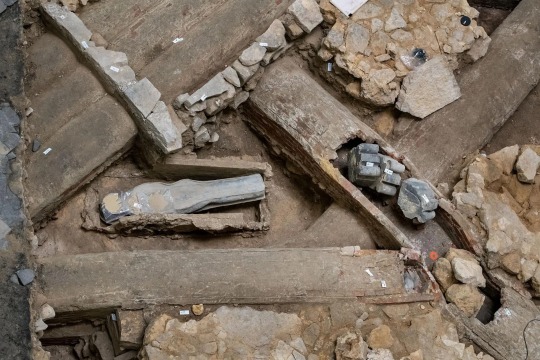

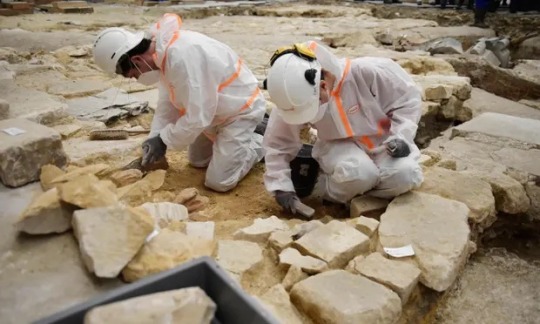
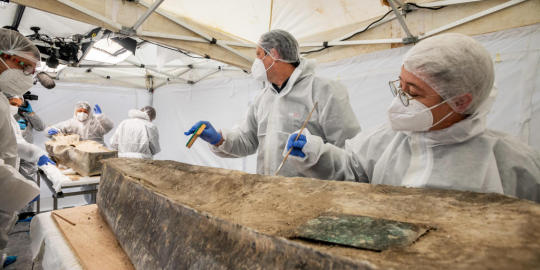



Notre Dame’s Uncovered Tombs Start to Reveal Their Secrets
Two sarcophaguses unearthed in reconstruction work after 2019 fire identified as elite canon of cathedral and young cavalier
Two lead sarcophaguses discovered buried under the nave at Notre Dame Cathedral in what was described as an “extraordinary and emotional” find have begun giving up their secrets, French scientists announced on Friday.
The first contains the remains of a high priest who died in 1710 after what experts say appeared to be a sedentary life. The occupant of the second has not yet been identified – and may never be – but is believed to be a young, wealthy and privileged noble who could have lived as far back as the 14th century.
The tombs were uncovered as part of a cache of statues, sculptures and fragments of the cathedral’s original 13th-century rood screen buried under the floor of the transept crossing at the heart of the cathedral that was ravaged by fire in April 2019.
The burial sites were described as of “remarkable scientific quality” and were found after a preventive dig under the floor where heavy scaffolding is to be erected to install the cathedral’s new spire.
While most of the treasures were discovered barely 20cm (8in) under the cathedral floor, a body-shaped lead sarcophagus was buried one metre deep.
Once opened by specialists in Toulouse, it was found to contain what was left of a man, probably in his 30s, who researchers have named “Le Cavalier”, as his pelvic bones suggest he was an experienced horseman.
There was no name plaque on the coffin, which was moulded around the shape of the body, and holes in the lead around the head meant the remains had been exposed to the air and severe deterioration.
Scientists are continuing to examine fragments of cloth and plant material found inside the coffin and say he was embalmed – a rare practice in the middle ages – and appears to have been buried with a crown of flowers.
A brass plaque on the second lead sarcophagus, also exposed to the air and water infiltration from the historic flooding of the Seine in 1910, confirmed that it contained the remains of Antoine de la Porte, the canon of Notre Dame Cathedral who died on Christmas Eve 1710 aged 83.
Eric Crubézy, professor of biological anthropology at the University of Toulouse III, who oversaw the cutting open of the coffins, said the two men were clearly important in their respective eras to have been buried in such prestigious tombs at the heart of the cathedral.
The unknown cavalier would have been a member of “the elite” at the time of his death to have been interred at the foot of the large cross on the since-destroyed rood screen, an ornate partition between the chancel and the nave that separated the clergy and choir from the congregation. Most rood screens were removed from France’s Catholic churches during the Counter-Reformation in the 16th and 17th centuries.
The young man had suffered a “chronic disease” that had destroyed most of his teeth by the time he died, Crubézy told journalists. “He would have had a difficult end of life.” The dead aristocrat also had a deformation of the skull caused by wearing a headdress or headband as a baby.
Christophe Besnier, who headed the scientific team for the dig carried out by France’s national archaeological institute, Inrap, told a press conference: “If the date of his death was around the second half of the 16th century or early 17th century, we may be able to identify him in the death register that we have. If it’s earlier than that, we probably won’t ever know who he was.”
Unlike the cavalier, de la Porte had “extraordinarily good teeth”, Crubézy said. “They were remarkable for his age. We see this very rarely, but he clearly cleaned his teeth and took care of them.”
De la Porte was rich, influential and not only commissioned several works of art that are now in the Louvre, including a painting by Jean Jouvenet entitled The Mass of Canon Antoine de la Porte, but paid 10,000 livres – a small fortune at the time – for the renovation of the choir of Notre Dame Cathedral. Part of the destroyed rood screen was used in constructing his tomb.
After fire swept through the 850-year-old cathedral, one of Paris’s most symbolic and visited monuments, in April 2019, almost destroying the entire edifice, President Emmanuel Macron pledged to have it rebuilt and open for mass in five years.
The Inrap team was called in to carry out a “preventive dig” under a section of the cathedral floor between February and April before a 30 metre-high, 600-tonne scaffold was built to reconstruct the monument’s spire. The archaeologists were given a strict timeframe and only a specific area in which to carry out the excavation.
Dominique Garcia, president of Inrap, reiterated that the human remains were not “archaeological objects” and would be treated “with respect from beginning to end” of the research before being returned to Paris for the culture ministry to decide what would happen to them.
By Kim Willsher.
#Notre Dame’s Uncovered Tombs Start to Reveal Their Secrets#sarcophaguses#grave#tomb#Antoine de la Port#the canon of Notre Dame Cathedral#archeology#archeolgst#ancient artifacts#history#history news#ancient history#notre dame cathedral#long reads
15 notes
·
View notes
Text
Top 10 Places to Visit in Delhi
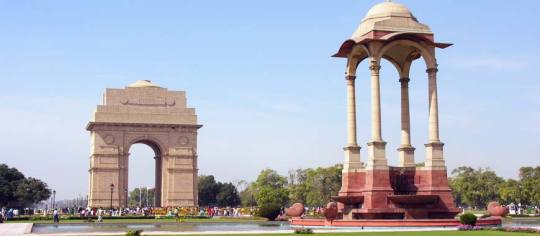
Delhi, the capital city of India, is a fascinating blend of rich history, vibrant culture, and modern development. With its diverse attractions, Delhi offers a myriad of experiences for every type of traveler. Whether you are a history enthusiast, a food lover, or someone seeking spiritual tranquility, Delhi has something for everyone. A tourist visiting the national capital of India must explore the top 10 places to visit in Delhi, each offering a unique glimpse into the city's multifaceted charm.
Red Fort (Lal Qila): The iconic Red Fort, a UNESCO World Heritage Site, stands as a majestic symbol of India's rich past. Built by the Mughal Emperor Shah Jahan in the 17th century, this colossal red sandstone fortress served as the main residence for Mughal emperors for nearly 200 years. The intricate architecture, including Diwan-i-Aam and Diwan-i-Khas, reflects the grandeur of the Mughal era. A visit to the Red Fort is a journey through history, with its stunning structures and well-maintained gardens.
Qutub Minar: Qutub Minar, another UNESCO World Heritage Site, is the world's tallest brick minaret and an exemplary masterpiece of Indo-Islamic architecture. Built in the early 13th century by Qutub-ud-din Aibak, the first ruler of the Delhi Sultanate, the minar is surrounded by ancient ruins, including the Quwwat-ul-Islam Mosque. The intricate carvings on the minaret and surrounding structures make it a must-visit for history and architecture enthusiasts.
India Gate: India Gate, an iconic war memorial, honors the soldiers who sacrificed their lives during World War I. This majestic arch stands at the heart of New Delhi and is surrounded by lush lawns, making it a popular spot for picnics and evening strolls. The Amar Jawan Jyoti, an eternal flame, burns in memory of the unknown soldiers, adding a solemn touch to the impressive structure.
Humayun's Tomb: Humayun's Tomb, another UNESCO World Heritage Site, is a stunning example of Mughal architecture and a precursor to the Taj Mahal. Built in the mid-16th century, this tomb is the final resting place of the Mughal Emperor Humayun. The symmetrical garden layout, intricate lattice work, and use of red sandstone showcase the Mughal aesthetic at its peak, making it a serene and visually captivating destination.
Lotus Temple: The Lotus Temple, a Bahá'í House of Worship, is renowned for its distinctive lotus-shaped architecture and its message of unity and peace. Surrounded by lush gardens, the temple is open to people of all faiths and beliefs, providing a tranquil space for meditation and contemplation. The architectural marvel and the serene atmosphere make the Lotus Temple a unique and spiritually enriching experience.
Akshardham Temple: Akshardham Temple, a relatively modern marvel, is a sprawling complex dedicated to showcasing Indian art, culture, and spirituality. The intricately carved central monument, surrounded by the Yagnapurush Kund, reflects traditional Indian craftsmanship. The Sahaj Anand Water Show and the cultural boat ride are must-see attractions within the complex, offering a multimedia and immersive experience.
Jama Masjid: Jama Masjid, one of the largest mosques in India, is an architectural marvel built by the Mughal Emperor Shah Jahan. Completed in 1656, the mosque's grand courtyard can accommodate thousands of worshippers. Climbing the minaret provides a breathtaking panoramic view of Old Delhi, offering a glimpse into the city's historical and cultural tapestry.
National Museum: For those interested in India's rich cultural heritage, the National Museum is a treasure trove of artifacts spanning over 5,000 years. The museum houses a vast collection of sculptures, paintings, decorative arts, and archaeological finds, providing a comprehensive overview of India's artistic and cultural evolution. From ancient civilizations to modern art, the National Museum offers a fascinating journey through time.
Gurudwara Bangla Sahib: A spiritual oasis in the heart of Delhi, Gurudwara Bangla Sahib is one of the most prominent Sikh shrines. The shimmering Sarovar (pond), the soothing Kirtan (devotional music), and the community kitchen serving free meals (Langar) create a serene and inclusive atmosphere. Visitors of all faiths are welcome, making it a symbol of harmony and unity.
Dilli Haat: Dilli Haat is a vibrant cultural and shopping destination that showcases the diversity of India's handicrafts and cuisine. This open-air market features stalls representing various states, offering a wide array of traditional handicrafts, textiles, and regional delicacies. The lively ambiance, cultural performances, and the opportunity to interact with artisans make Dilli Haat a delightful and immersive experience. Delhi, with its kaleidoscopic blend of history, culture, and modernity, invites travelers to explore its myriad facets. Each of these top 10 places contributes to the city's allure, offering a unique perspective on Delhi's rich tapestry. Whether you are wandering through ancient monuments, savoring diverse cuisines, or finding solace in spiritual havens, Delhi promises a journey of discovery and wonder. Optima Travels offers several Delhi day tour packages.
0 notes
Text

THIS EXTREMELY PLEASING MARBLE SCULPTURE HAS TRACES OF ITS ORIGINAL POLYCHROME DECORATION, POSSIBLY ORIGINALLY PART OF A STRUCTURE SUCH AS A TOMB.
Visit us at: https://www.periodoakantiques.co.uk/antique-carvingsworks-of-art/a-small-16th-century-marble-lion-c1540-10-stockno-1721/
0 notes
Text
Experience India: The e-Tourist Visa Advantage
The Indian e-tourist Visa offers expedited entry to India for eligible travelers. With a simple online application, applicants can secure their visa swiftly. This electronic authorization allows for stays of up to 90 days for tourism, recreation, or short-term medical treatment. Fast processing ensures convenience, typically within 72 hours. Upon approval, travelers receive an electronic visa directly to their email, eliminating the need for physical paperwork. This hassle-free process streamlines travel arrangements, promoting tourism and fostering cultural exchange. Enjoy the wonders of India with ease, courtesy of the efficient e-tourist Visa system.
categories of India e-tourist visa
The Indian 5-year e-Tourist Visa grants multiple entries, ideal for frequent travelers seeking extended stays. Explore India's diverse culture and heritage with convenience and flexibility. Apply online effortlessly.
The Indian 1-year e-tourist Visa offers convenience for mid-term stays, with multiple entries permitted. Experience India's rich culture and attractions at your own pace. Apply easily online for hassle-free travel.
The Indian 30-day e-Tourist Visa allows for short-term visits, perfect for quick exploration or business trips—Experience India's vibrant culture and sights with ease. Apply online for swift processing and convenience.
famous in Delhi tourist places
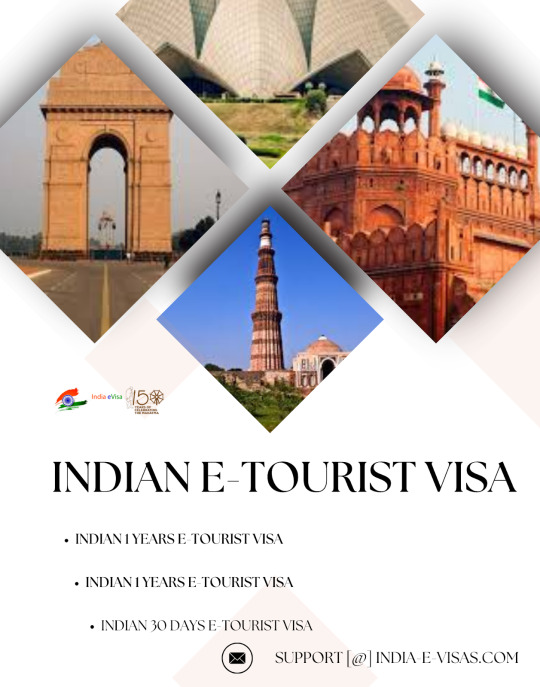
Red Fort: Built in the 17th century by Emperor Shah Jahan, the Red Fort is a majestic symbol of Mughal architecture. Its imposing red sandstone walls enclose palaces, pavilions, and lush gardens, reflecting the grandeur of India's imperial past.
Jama Masjid: Adjacent to the Red Fort lies the Jama Masjid, one of the largest mosques in India. Constructed by Shah Jahan, this architectural marvel features intricate marble domes, minarets, and a vast courtyard, inviting visitors to marvel at its beauty and serenity.
Qutub Minar: A UNESCO World Heritage Site, the Qutub Minar is an iconic landmark in Delhi. Standing at 73 meters tall, this ancient minaret is adorned with intricate carvings and inscriptions, offering a glimpse into Delhi's rich cultural heritage.
Lotus Temple: Shaped like a blooming lotus flower, the Lotus Temple is a modern architectural wonder and a symbol of unity and peace. Visitors flock to this Bahá'í House of Worship to meditate, reflect, and admire its serene surroundings.
India Gate: A towering war memorial, India Gate pays homage to the soldiers who sacrificed their lives during World War I. Designed by Sir Edwin Lutyens, this majestic arch stands as a testament to India's valor and resilience.
Chandni Chowk: Delhi's oldest and busiest market, Chandni Chowk is a sensory delight for visitors. Its labyrinthine lanes are filled with street food stalls, spice shops, and traditional boutiques, offering a glimpse into the city's vibrant culture and heritage.
Humayun's Tomb: A UNESCO World Heritage Site, Humayun's Tomb is a splendid example of Mughal architecture. Built in the 16th century, this mausoleum is surrounded by lush gardens and reflects the grandeur of the Mughal era.
Akshardham Temple: A modern marvel of Indian architecture, the Akshardham Temple is dedicated to Lord Swaminarayan. Its intricately carved pillars, domes, and sculptures showcase the rich cultural heritage of India.
National Museum: Housing a vast collection of artifacts, paintings, and sculptures, the National Museum offers a comprehensive overview of India's history and culture. Visitors can explore exhibits spanning thousands of years, from ancient artifacts to contemporary art.
Gurudwara Bangla Sahib: One of the most prominent Sikh gurdwaras in Delhi, Gurudwara Bangla Sahib is known for its golden dome and serene Sarovar (pool). Visitors can experience the community kitchen (langar) and participate in religious ceremonies.
Raj Ghat: A serene memorial dedicated to Mahatma Gandhi, Raj Ghat is where the father of the nation was cremated. Surrounded by beautiful gardens, it serves as a peaceful tribute to his life and legacy.
National Zoological Park: Spread over a vast area, the National Zoological Park is home to a diverse range of animal species, including rare and endangered ones. It offers visitors a chance to observe wildlife in a natural habitat setting.
conclusion
Delhi's famous tourist places offer a captivating blend of history, culture, and spirituality, giving visitors a glimpse into the rich tapestry of India's heritage. Whether exploring ancient monuments, marveling at modern architectural marvels, or immersing oneself in the vibrant atmosphere of bustling markets, Delhi promises an unforgettable journey through time and tradition.
The Indian e-tourist Visa offers expedited entry to India for eligible travelers. With a simple online application, applicants can secure their visa swiftly. This electronic authorization allows for stays of up to 90 days for tourism, recreation, or short-term medical treatment.
#indiantouristvisa#visa#indiantouristvisaupdate#indianvisaapplication#ivisa#delhitourguide#delhitrip#delhitourplan#jamamasjid#thingstodoindelhi#chandnichowk#famousplacesindelhi#akshardham
1 note
·
View note
Text
Unraveling Hidden Gems in Delhi: Explore Offbeat Treasures with Geniefie!
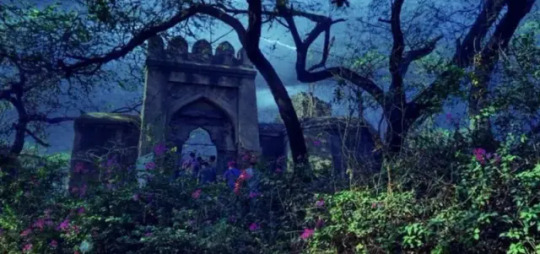
Hey there, urban explorers and adventure seekers! Are you ready to dive into the heart of Delhi and uncover its best-kept secrets? Well, buckle up because we’re about to embark on a wild ride through the unexplored nooks and crannies of the city with Geniefie – Unbox Locations feature!
Picture this: you’ve roamed the bustling streets of Connaught Place, marveled at the grandeur of India Gate, and savored the flavors of Chandni Chowk. But guess what? Delhi has so much more to offer beyond its iconic landmarks. And that’s where Geniefie swoops in to save the day!
With Geniefie – Unbox Places feature, you’ll unlock a treasure trove of hidden gems and offbeat destinations that even seasoned Delhiites may not know about. So, dust off your adventurous spirit and get ready to explore the unexplored!
First up, let’s take a stroll through the enchanting Mehrauli Archaeological Park. Tucked away amidst lush greenery, this historical gem boasts ancient ruins, centuries-old tombs, and serene jogging trails that’ll transport you back in time.
Feeling a bit artsy? Head over to the Kiran Nadar Museum of Art, where contemporary masterpieces and thought-provoking installations await. Get lost in a world of creativity and imagination as you soak in the vibrant colors and bold expressions of Indian artists.
But wait, there’s more! Ever heard of the serene tranquility of the Garden of Five Senses? This hidden oasis is a sanctuary for nature lovers, offering landscaped gardens, artistic sculptures, and peaceful walking paths where you can unwind and reconnect with Mother Nature.
And let’s not forget about the quirky charm of Hauz Khas Village. Beyond its trendy cafes and bustling nightlife lies a hidden reservoir surrounded by ancient monuments and panoramic views of the city skyline. It’s the perfect spot for a leisurely afternoon picnic or a romantic sunset rendezvous.
Now, here’s the best part: planning your adventure with Geniefie couldn’t be easier! Simply fire up the app, activate the Unbox feature, and voila! You’ll have access to a curated list of unexplored locations, complete with insider tips, directions, and reviews from fellow travelers.
So, what are you waiting for? Grab your phone, unleash your inner explorer, and let Geniefie be your trusty guide to uncovering the hidden treasures of Delhi. With Geniefie, every adventure is a story waiting to be told!
Discover Delhi’s hidden gems with Geniefie!
Bhuli Bhatiyari ka Mahal
Nestled in a dense forest near Karol Bagh, Bhuli Bhatiyari ka Mahal is a monument maintained and preserved for sustenance by the Archaeological Survey of India. Feroz Shah Tughlaq built this fort as a hunting lodge in the late 14th century.
There are no chains or locks on the gate, but there is only a warning sign that warns anyone not to come after sunset as haunted and paranormal tales have been experienced by the tourists here. It is said that if anyone stays here after night he/she either gets mad or dies. This place is popular among youngsters and Bravehearts, who wander here to explore and justify the haunted claims.
Location:Asola WildLife Sanctuary, Asola, New Delhi.
Timing(If applicable):Monday to Friday – 9.30 am to 5 pm
Adham Khan’s Tomb
Adham Khan’s Tomb is located in close proximity to Qutub Minar and was built in the 16th-century. Adham Khan was a minister of the royal court of Akbar, and he was also the son of Akbar’s wet nurse Maham Anga. The Mughal Emperor Akbar built this monument after Adham Khan killed one of Akbar’s favorite courtesans.
The tomb stands on the wall of a Rajput fortress called the Lal Kot. An interesting fact about this tomb is that it is octagonal in shape, and not the typical hexagon to signify it is a traitor’s tome.
Location: Seth Sarai, Mehrauli, New Delhi, Delhi 110030.
Bhardwaj Lake
Bhardwaj Lake is considered to be one of the most beautiful hidden places in Delhi that was formed due to the mining of Lime, Badarpur, and Sandstone sand in the region. Pebbles and sand are not the only things you will find here; the surrounding area is also home to a number of birds, butterflies, and insects.
Some claim that you can also witness wild animals over here. The surrounding semi-arid forest has one of the most adventurous nature trails. It has been catching the attention of trek lovers in recent years as the rocky paths make for interesting hikes.
Location: Asola WildLife Sanctuary, Asola, New Delhi.
Timing: 9.30 am to 5 pm- Monday to Friday
Closed on Weekend.
Sanjay Van
Spread across the area of 443 acres, Sanjay Van is the most widely spread forest area in Delhi. It is one of the most interesting secret places in Delhi where you can witness a number of species of birds and animals. The birds dwelling there include Eurasian golden oriole, purple sunbird, Asian koel, starling, Indian silverbill, white-throated kingfisher, etc.
It is also home to jackals, snakes, nilgais, and several species of butterflies. Sanjay Van is also known for its paranormal occurrences. The fear is often connected to a nearby crematorium and several unclaimed bodies found in the dense forest.
Location: Vasant Kunj, New Delhi.
Satpula Bridge
One of the oldest hidden places in Delhi, Satpula Bridge, was built about 700 years ago by the Tughluq dynasty. It is one of the oldest dams in the city and is surprisingly close to the suburb Saket. ‘Satpula’ translates to seven bridges, and is rightly called so as the dam is built on seven arches. The structure is still intact despite centuries of degradation.
This dam was intelligently built to regulate water for irrigation. Locals believe that the water, which has now dried up, had healing powers because saint Nasiru’d-Din Mahmud performed ablution there. There are Octagonal chambers at the sides of the structure, which are said to have once been a Madrassa. Tourists flock to this place in numbers to experience calm and serenity.
Location: Khirki Village, Malviya Nagar, New Delhi.
To discover more Unexplored places, Download Geniefie Trip Planner App!
0 notes
Text
Discover the Top 10 Historical Places in Delhi: A Comprehensive Guide
Delhi, India's capital, is a city saturated with a rich tapestry of history and culture.From ancient empires to modern times, Delhi has been a witness to centuries of historical events, making it a treasure trove of historical sites. In this comprehensive guide, we will take you on a journey through the top 10 historical places in Delhi that showcase the city's rich and diverse heritage. Whether you're a history enthusiast or a traveler looking to explore the past, these sites offer a fascinating glimpse into India's history.
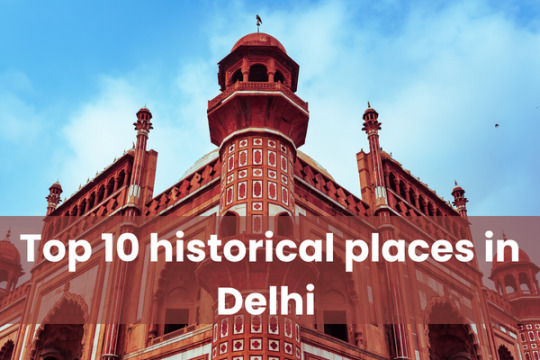
1. Red Fort
The Red Fort, also known as Lal Qila, is one of Delhi's most iconic historical landmarks. Commissioned by Emperor Shah Jahan during the 17th century, it functioned as the primary abode for the Mughal emperors. The fort's stunning red sandstone architecture and intricate design, including the Diwan-i-Aam and Diwan-i-Khas, make it a UNESCO World Heritage Site. A visit to the Red Fort is a step back in time to the grandeur of the Mughal era.
2. Qutub Minar
Qutub Minar is another UNESCO World Heritage Site and a symbol of Delhi's ancient history. This 73-meter-high minaret was built in the 12th century by Qutb-ud-din Aibak. The complex also includes the Quwwat-ul-Islam Mosque, which is one of the earliest mosques in India. The intricate carvings and the impressive height of the Qutub Minar make it a must-visit historical site.
3. Humayun's Tomb
Humayun's Tomb, a majestic Mughal mausoleum, is a testament to the exquisite Mughal architecture. Built in the mid-16th century, it predates the Taj Mahal and is often considered a precursor to it. The beautifully landscaped gardens and the tomb's symmetrical design are its defining features. It is also a UNESCO World Heritage Site and a place of serenity and historical significance.
4. India Gate
India Gate is a war memorial and an iconic symbol of Delhi. It was built in honor of the soldiers who sacrificed their lives during World War I. The Amar Jawan Jyoti, an eternal flame, is situated under the arch and represents the sacrifices made by the Indian Armed Forces. The lush green lawns around India Gate make it a popular spot for picnics and evening walks.
5. Jama Masjid
Jama Masjid is one of the largest mosques in India and an architectural masterpiece of the Mughal era. Commissioned by Shah Jahan, the mosque can accommodate over 25,000 worshippers. Its red sandstone and white marble construction, along with the stunning views from its minarets, create an awe-inspiring atmosphere. Visitors can also explore the bustling markets of Old Delhi surrounding the mosque.
6. Lotus Temple
The Lotus Temple is a modern architectural marvel and a symbol of religious harmony. Shaped like a lotus flower, it is a Bahá'í House of Worship where people of all faiths are welcome to meditate and pray. The structure is made of white marble and is surrounded by lush gardens, creating a serene and contemplative environment.
7. Akshardham Temple
Swaminarayan Akshardham Temple is a sprawling complex dedicated to spirituality and art. It houses the Akshardham Mandir, a magnificent temple with intricate carvings, and the Yagnapurush Kund, the world's largest stepwell. The temple also features exhibitions and light and sound shows that narrate India's rich cultural and spiritual heritage.
8. National Museum
The National Museum in Delhi is a treasure trove of historical artifacts, art, and sculptures. It showcases India's rich cultural heritage through its extensive collection. From ancient archaeological finds to medieval and modern art, the museum provides a comprehensive view of India's history and artistic evolution.
9. Tughlaqabad Fort
Tughlaqabad Fort, built by Ghiyas-ud-din Tughlaq in the 14th century, is a massive fortress that reflects the architectural prowess of the Tughlaq dynasty. The fort's ruins are a striking sight, with its imposing walls and the tomb of Ghiyas-ud-din Tughlaq. Exploring this fort is like stepping into a different era of Delhi's history.
10. Raj Ghat
Raj Ghat is a simple yet profound memorial to Mahatma Gandhi, the father of the nation. It is a black marble platform marking the spot of his cremation in 1948. Surrounded by beautifully maintained gardens, Raj Ghat is a place of reflection and homage to the great leader who played a pivotal role in India's struggle for independence.
Conclusion
Delhi's historical sites are not just monuments; they are windows into India's rich and diverse history. From the grandeur of the Mughal era to the architectural marvels of modern times, the top 10 historical places in Delhi offer a captivating journey through the ages. Whether you're interested in architecture, art, spirituality, or simply exploring the past, Delhi's historical treasures have something to offer every visitor. So, plan your trip to Delhi and immerse yourself in the city's remarkable heritage.
1 note
·
View note
Text
Best Places to Visit in Hyderabad: A Comprehensive Guide
Explore the City of Pearls with ChikuCab's Innova Crysta Rental Services
Hyderabad, the capital city of Telangana, is a captivating blend of tradition and modernity. Steeped in history, the city boasts an array of architectural wonders, bustling markets, and delectable cuisine that is sure to enchant any traveler. When it comes to exploring this vibrant metropolis, ChikuCab's Innova Crysta rental services provide the ideal way to navigate the city's many attractions. In this guide, we'll take you through the best places to visit in Hyderabad and how ChikuCab can enhance your travel experience.
1. Charminar: The Iconic Landmark
No visit to Hyderabad is complete without beholding the iconic Charminar. This 16th-century architectural marvel stands as a testament to the city's historical legacy. Its four grand arches, intricate stonework, and minarets create a sight that is both majestic and nostalgic. Surrounding Charminar is the bustling Laad Bazaar, where you can indulge in shopping for exquisite bangles, traditional textiles, and delectable street food.
2. Golconda Fort: A Glimpse into the Past
For history enthusiasts, the Golconda Fort is a must-visit destination. This sprawling fort complex offers panoramic views of the city and an opportunity to explore its grand halls, royal chambers, and ingenious acoustic system. The Light and Sound Show conducted here in the evenings brings the history of Golconda to life, narrating tales of its illustrious past.
3. Qutub Shahi Tombs: Architectural Grandeur
A short distance from Golconda Fort lies the Qutub Shahi Tombs, a stunning necropolis that houses the final resting places of the Qutub Shahi dynasty rulers. The tombs are an architectural masterpiece, featuring a blend of Persian, Hindu, and Pathan styles. The peaceful atmosphere and intricate detailing make this site a hidden gem for those seeking tranquility and historical fascination.
4. Ramoji Film City: Bollywood in Hyderabad
Experience the magic of the silver screen at Ramoji Film City, one of the largest film studios in the world. This sprawling complex offers guided tours that take you through sets, soundstages, and impressive recreations of famous landmarks. It's a treat for movie buffs and those interested in the behind-the-scenes action of filmmaking.
5. Hussain Sagar Lake: Serenity in the City
Escape the urban hustle by visiting Hussain Sagar Lake, a tranquil oasis in the heart of Hyderabad. The lake offers boating opportunities and a stunning panoramic statue of Lord Buddha installed on an island in the center. The Necklace Road that skirts the lake is a popular spot for leisurely walks and enjoying picturesque sunsets.
6. Salar Jung Museum: Art and Artefacts
Art aficionados will be enthralled by the Salar Jung Museum, home to an extensive collection of artifacts from around the world. The museum's diverse exhibits include sculptures, paintings, textiles, manuscripts, and decorative arts. It's a cultural treasure trove that provides a glimpse into various civilizations and artistic traditions.
7. Birla Mandir: Spiritual Splendor
Perched on a hillock, the Birla Mandir is a stunning marble temple dedicated to Lord Venkateswara. The temple's architecture and serene atmosphere offer a welcome respite from the city's hustle. Visitors can revel in breathtaking views of the city from the temple premises.
8. Chowmahalla Palace: Regal Opulence
Step into the regal past of the Nizams at Chowmahalla Palace, a lavish palace complex showcasing the opulent lifestyle of Hyderabad's royals. The palace's stunning architecture, ornate halls, and lush gardens transport visitors to a bygone era of grandeur and elegance.
ChikuCab: Your Travel Companion
To make the most of your Hyderabad adventure, ChikuCab's Innova Crysta rental services are your ultimate travel companion. Navigating the city's diverse attractions and vibrant neighborhoods becomes a breeze with ChikuCab's comfortable and reliable vehicles. Whether you're traveling solo, with family, or in a group, their well-maintained Innova Crysta fleet ensures a smooth and enjoyable journey.
ChikuCab not only provides top-notch transportation but also prioritizes customer safety and satisfaction. With experienced drivers and transparent pricing, you can explore Hyderabad with peace of mind. From airport pickups to full-day city tours, ChikuCab offers flexible rental options tailored to your needs.
Conclusion
Hyderabad's rich cultural tapestry and historical landmarks make it a captivating destination for travelers. From the iconic Charminar to the serene Hussain Sagar Lake, each place has a unique story to tell. Enhance your exploration of this city of pearls by choosing ChikuCab's Innova Crysta rental in hyderabad, ensuring that your journey is as memorable as the destinations themselves. Experience Hyderabad's blend of tradition and modernity with the comfort and convenience of ChikuCab's reliable transportation services.
#innova crysta rental hyderabad#innova crysta hire in hyderabad#innova crysta car hire hyderabad#innova crysta on rent in hyderabad#innova crysta rental in hyderabad#innova crysta for rent in hyderabad
0 notes
Photo

Tomb of a woman from the Adelsheim family in Germany, 1543
#tomb#germany#releif#16th c. Germany#german style#mdpsculpture#16th c. sculpture#1540s#16th century#1543
77 notes
·
View notes
Text
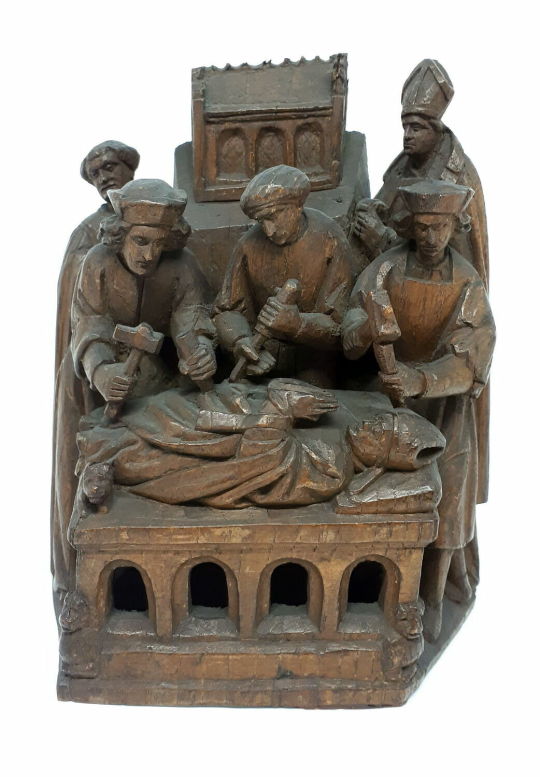
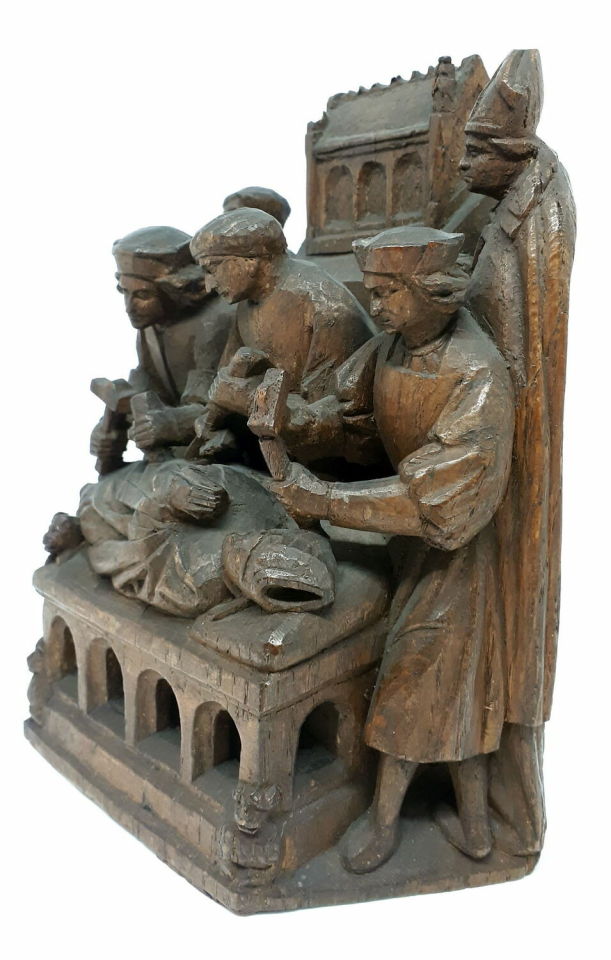
Anonymous. Groupe sculpté avec cinq personnage (Sculpted Group With Five Figures). Oak. 16th century. Louvre Museum (not currently on view) page on museum site
What I like about this little piece is how it almost feels like it's breaking the artistic 4th wall. The central figure at first seems to be the prone figure of a bishop with his hands raised above his chest in prayer. But then it quickly becomes clear that this bishop is a sculpture within a sculpture. It is the artists crafting this sculpture who are the real subject of the piece and who most grabbed my attention. They are engrossed in their work, crafting the sculpture to sit atop the tomb of a bishop, their expressions showing a tender dedication to the craft. In fact, they look a lot more saintly than the slightly hunched and sour-faced bishop who stands behind them.
This man, placed squarely in the background despite his higher status, seems to be the patron of the effigy being sculpted (whether it's his own effigy or that of his predecessor is something I'm not sure on, though it seems more likely to be the later given the lack of resemblance). He and his acolyte are watching on, wanting to get their money's worth, but they are squarely outside of the action, secondary to the act of creation itself.
#analysis purely my own#I don't claim to be an expert on art history#just someone who loves it#art history#art#sculpture#gothic art#16th century#louvre#louvre museum#musee du louvre#museums#art analysis#wood sculpture#european art#anonymous art
0 notes
Photo


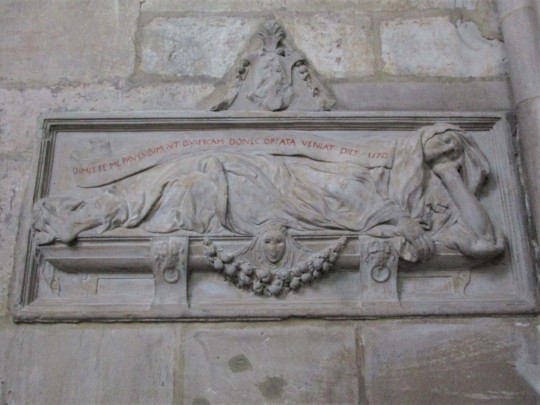
The 16th century sculptures at the Basilica of Saint-Urbain in Troyes include St. Roche, St. George (I think) subduing a terrific Satan, and a recumbent figure of a woman that must have been part of a tomb or memorial. The Latin on the scroll says, “Let me rest until the day so desired comes. 1570″
Photos by Charles Reeza
#religious art#stone sculpture#polychrome#saints#devil#demon#dragon#catholic church#France#Troyes#travel photos
8 notes
·
View notes
Text
Explore Delhi By Taxi

Exploring Delhi by taxi is a convenient and popular way to navigate the city and visit its various attractions. Delhi, the capital of India, is a bustling metropolis with a rich history, vibrant culture, and numerous landmarks. Here are some places you can explore in Delhi by taxi:
Red Fort (Lal Qila): Start your journey by visiting the iconic Red Fort, a UNESCO World Heritage Site. Explore the magnificent architecture of this historic fort, which was the residence of Mughal emperors.
Jama Masjid: Located near the Red Fort, Jama Masjid is one of the largest and most renowned mosques in India. Admire its stunning architecture and enjoy panoramic views of Delhi from its minarets.
Qutub Minar: Visit the Qutub Minar complex, another UNESCO World Heritage Site. The main attraction is the towering Qutub Minar, a medieval Islamic monument with intricate carvings.
Humayun's Tomb: Explore the beautiful Humayun's Tomb, a mausoleum built in the 16th century and considered a precursor to the Taj Mahal. It is surrounded by lush gardens and showcases stunning Mughal architecture.
India Gate: Take a taxi ride to India Gate, a prominent war memorial located in the heart of Delhi. Pay tribute to Indian soldiers and enjoy the open green space around the monument.
Lotus Temple: Visit the Lotus Temple, a Bahá'í House of Worship known for its unique lotus-shaped architecture. Enjoy the tranquil atmosphere and spend some time in meditation or reflection.
Akshardham Temple: Explore the grandeur of the Akshardham Temple, a modern Hindu temple complex known for its exquisite architecture, intricate carvings, and engaging exhibitions.
Chandni Chowk: Dive into the bustling streets of Chandni Chowk in Old Delhi, known for its vibrant markets, narrow lanes, and delicious street food. Experience the energy and shop for textiles, spices, and more.
National Museum: If you're interested in Indian art, history, and culture, the National Museum is worth a visit. It houses a vast collection of artifacts, including sculptures, paintings, and archaeological finds.
Lodhi Gardens: Enjoy a peaceful retreat at Lodhi Gardens, a serene green space dotted with historical tombs and beautiful landscapes. It's an ideal place for a leisurely stroll or a picnic.
When exploring Delhi by taxi, it's advisable to plan your itinerary in advance to optimize your time. Choose a reputable taxi service, negotiate the fare or use the meter, and communicate your desired destinations to the driver clearly. Consider the traffic conditions, especially during peak hours, to allow sufficient time for travel.
Remember to carry a city map or use a navigation app to track your route and ensure you're heading in the right direction. Delhi can be crowded and chaotic at times, so patience and awareness are essential while traveling by taxi.
Enjoy your exploration of Delhi's rich history, cultural treasures, and vibrant atmosphere!
How To Book Taxi in Delhi
Booking a taxi in Delhi is a relatively straightforward process, and there are several options available to do so. Here are a few common methods to book a taxi in Delhi:
Online Taxi Aggregators: There are several popular online taxi aggregator platforms available in Delhi, such as GTC Cabs, Uber and Ola. You can book a taxi using their respective mobile apps or websites. Follow these steps:
Download the app from your smartphone's app store or visit the official website.
Sign up or create an account if you're a new user.
Enter your pickup location and destination.
Choose the type of cab you prefer (e.g., hatchback, sedan, or SUV).
Review the estimated fare and confirm the booking.
You can track the taxi's location and estimated arrival time through the app.
Dedicated Taxi Company Websites: Many taxi companies in Delhi have their own websites through which you can book a taxi. Some popular taxi services in Delhi include GTC Cabs, Meru Cabs, Mega Cabs, and Easy Cabs. Visit their websites and follow the booking instructions provided.
Phone Booking: If you prefer the traditional method, you can book a taxi by calling the taxi service directly. Look for the contact information of the preferred taxi service in Delhi and dial their customer support or booking hotline. Provide your pickup location, destination, and any other necessary details as requested by the operator.
Hotel Concierge: If you are staying at a hotel in Delhi, the hotel concierge can assist you in booking a taxi. They can provide you with reliable taxi services and arrange the booking on your behalf. Simply approach the concierge desk, inform them of your travel plans, and they will handle the rest.
When booking a taxi in Delhi, it's important to keep the following considerations in mind:
Specify your pickup location clearly, including landmarks or nearby points of reference, to ensure the taxi driver can find you easily.
Communicate your destination clearly to the taxi driver and confirm that they understand where you want to go.
Verify the fare and any additional charges before confirming the booking to avoid any surprises.
If possible, carry a map or use a navigation app on your smartphone to track the route and ensure you are heading in the right direction.
Consider the time of day and traffic conditions, especially during peak hours, to allow for sufficient travel time.
Remember to prioritize your safety and only book taxis from reputable and licensed services.
Best Taxi Service in Delhi
There are several reputable taxi services in Delhi, and the "best" service can vary based on individual preferences and requirements. However, here are a few well-known and reliable taxi services in Delhi that you can consider:
GTC Cabs: GTC Cabs is a trusted taxi service in Delhi with a fleet of well-maintained vehicles. They provide 24/7 service, including airport transfers, and prioritize customer safety and comfort.
Uber: Uber is a popular and widely used taxi service in Delhi. Their app-based platform allows you to book a ride conveniently, track your driver's location, and make cashless payments.
Ola Cabs: Ola is another major player in the taxi service industry in Delhi. Similar to Uber, Ola provides a user-friendly app that enables you to book rides, select the type of vehicle, and pay electronically.
Meru Cabs: Meru Cabs is a well-established taxi service known for its professional drivers and reliable service. They offer a range of vehicle options and can be booked through their website or app.
Easy Cabs: Easy Cabs is a popular choice for taxi services in Delhi. They offer competitive fares, well-trained drivers, and a straightforward booking process through their app or website.
When selecting a taxi service, consider factors such as safety, reliability, availability, customer reviews, and fare transparency. It can be helpful to compare prices and read customer feedback to make an informed decision based on your specific needs.
Please note that while I provide information based on general knowledge, it's always a good idea to check the current offerings, availability, and customer reviews of each taxi service directly through their websites or apps to ensure the most up-to-date information.
0 notes
Text
Best visiting places in Delhi
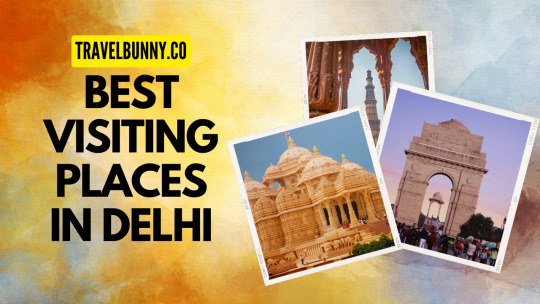
Delhi is a city with a rich history, culture, and many diverse attractions that are worth exploring. Here are some popular destinations to consider when planning a trip to Delhi:
Red Fort: A UNESCO World Heritage Site, the Red Fort is a magnificent fortress built in the 17th century that served as the residence of the Mughal emperors.
India Gate: A national monument and war memorial, India Gate is a must-visit destination in Delhi. Located in the heart of the city, it is a popular spot for picnics and evening walks.
Qutub Minar: Another UNESCO World Heritage Site, the Qutub Minar is a 73-meter tall tower built in the 12th century. It is surrounded by several other historic structures, making it a popular destination for history buffs.
Humayun's Tomb: This magnificent mausoleum was built in the 16th century and is considered a masterpiece of Mughal architecture. It is a must-visit destination for anyone interested in history, architecture, or photography.
Akshardham Temple: A stunning temple complex built in 2005, the Akshardham Temple is a testament to India's rich spiritual and cultural heritage. It is known for its intricate carvings, sculptures, and stunning architecture.
Chandni Chowk: One of Delhi's oldest and busiest markets, Chandni Chowk is a bustling hub of activity and a great place to shop for souvenirs, spices, and other goods.
Lotus Temple: A unique architectural masterpiece, the Lotus Temple is a stunning temple shaped like a lotus flower. It is a popular destination for people of all faiths and beliefs.
Jama Masjid: One of the largest mosques in India, Jama Masjid was built in the 17th century and is a stunning example of Mughal architecture. Visitors can climb to the top of the mosque's minaret for panoramic views of the city.
Raj Ghat: A peaceful memorial dedicated to Mahatma Gandhi, Raj Ghat is a must-visit destination for anyone interested in India's independence movement.
National Museum: The National Museum in Delhi is home to a vast collection of artifacts, artworks, and historical objects that provide a glimpse into India's rich cultural and artistic heritage.
Lodi Gardens: A serene and peaceful oasis in the heart of Delhi, Lodi Gardens is a great place to go for a walk or a picnic. It is also home to several historic tombs and monuments.
Hauz Khas Village: A trendy and hip neighborhood in South Delhi, Hauz Khas Village is known for its eclectic mix of bars, restaurants, and art galleries. It is a great place to spend an evening.
Dilli Haat: A popular open-air market that showcases the handicrafts, food, and culture of various regions of India, Dilli Haat is a great place to shop for souvenirs and enjoy local cuisine.
Swaminarayan Akshardham: A Hindu temple complex that is one of the largest in the world, Swaminarayan Akshardham is known for its stunning architecture and beautiful gardens.
Gurudwara Bangla Sahib: One of the most prominent Sikh temples in Delhi, Gurudwara Bangla Sahib is known for its stunning golden dome and serene atmosphere. Visitors can participate in the daily langar (community meal) and learn about Sikhism.
Rashtrapati Bhavan: The official residence of the President of India, Rashtrapati Bhavan is a grand colonial-era building that is open to the public for guided tours. Visitors can admire the beautiful gardens, historic rooms, and artwork.
Daryaganj Book Market: A haven for book lovers, Daryaganj Book Market is a popular destination for second-hand books, rare books, and academic publications. It is open on Sundays and attracts visitors from all over the city.
Chhatarpur Temple: A massive temple complex dedicated to the goddess Katyayani, Chhatarpur Temple is a popular destination for devotees and tourists alike. It features beautiful gardens, shrines, and sculptures.
Nehru Planetarium: A fascinating destination for science enthusiasts, Nehru Planetarium offers interactive exhibits, documentaries, and shows on astronomy and space science.
National Handicrafts and Handlooms Museum: A museum dedicated to Indian handicrafts and handlooms, this destination is perfect for those who want to learn about traditional arts and crafts from different parts of the country.
These are just a few of the many interesting places to visit in Delhi. Whether you are interested in history, culture, religion, or science, there is something for everyone in this vibrant city.
1 note
·
View note